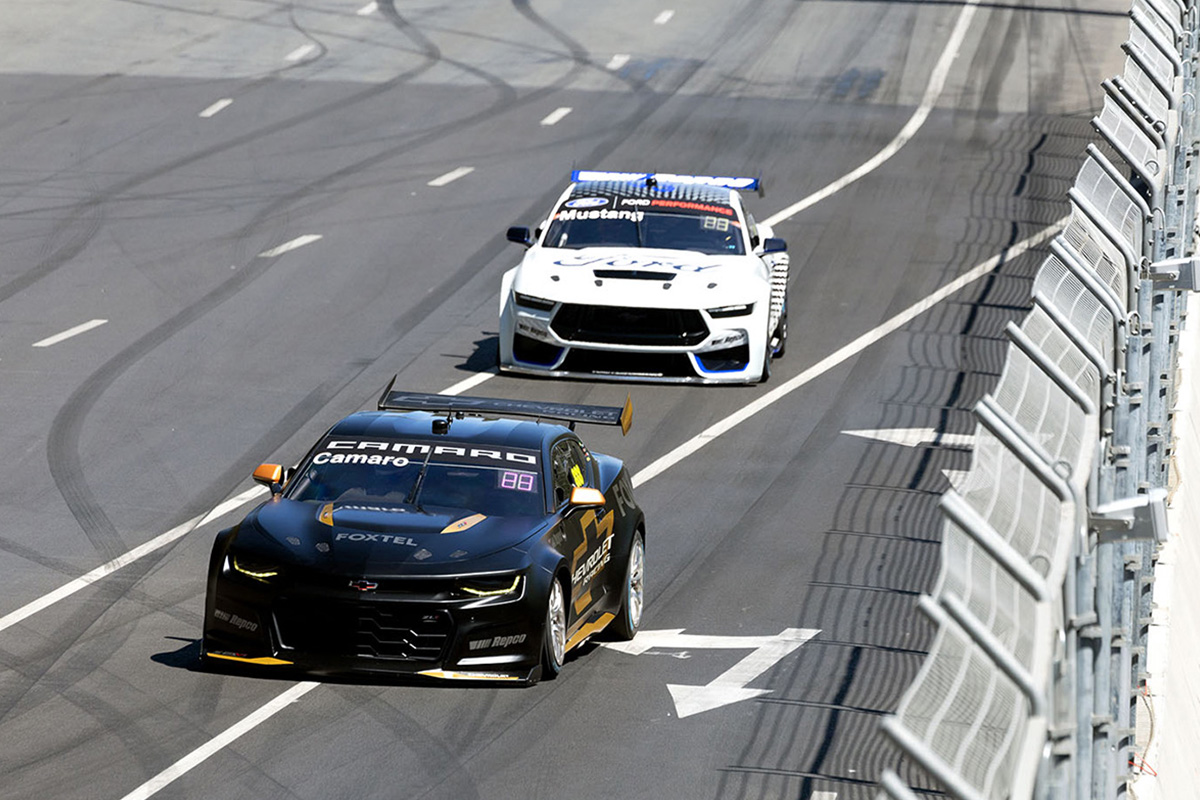

The Gen3 formula will debut in the Repco Supercars Championship this season after years of work behind the scenes – and that work is not over yet.
The Chevrolet Camaro replaces the Holden ZB Commodore and the S650 Ford Mustang takes over from the S550 road car-inspired Gen2 model, meaning two doors for both brands.
As it stands, most of the paddock has made solid progress on car builds, however, the first shakedowns are only a matter of days away and some parts are still yet to be signed off on, including the rear wing on the Ford.
Before that, Supercars is set for critical additional homologation testing with the Camaro and Mustang, beginning later this week.
As we reach the final stages of the Gen3 cars hitting the track, Speedcafe.com takes a look back at the journey so far.
The move from the Holden Commodore and Ford Falcon as Supercars’ warhorses began when Ford Australia pulled the pin on local manufacturing after nine decades. Announced in May 2013, by the end of that year General Motors also confirmed the worst for Holden, confirming its Australian production to also end.
While Holden confirmed the German-made Opel Insignia, known here as the ZB Commodore, as the replacement for the final Australian-made VF II Commodore ahead of Holden’s final plant closure in 2017, General Motors sold Opel to PSA (Peugeot-Citroen, since absorbed into the larger Stellantis Group) – cue the Dick Johnson jokes where he referred to the Commodore as a ‘Peugeot’.
The sale of Opel to PSA meant that Holden could not rely on the next-generation of Opel to replace its ZB Commodore – a solution had to be found both in showrooms and on race circuits. Sadly, the demise of the Holden brand came in 2020, when it officially exited the market. General Motors promised to uphold its legal obligation to maintain spare parts for the vehicles it had sold for the following decade.
On track, that meant that Holden would end once the ZB Commodore’s racing career in the main game ended. That saw its final race at last December’s Adelaide round in a fitting and emotional farewell.
On the Ford front, the last Falcon rolled off its Broadmeadows production line in October 2016 – the Thai-built Ranger now its best-seller. The FG X Falcon raced on until the end of 2018, when the S550 Ford Mustang took over.
At the season-opener in Adelaide in 2019, Scott McLaughlin stamped his authority on the title. The Mustang instantly became a formidable warhorse and the subject of controversy, based on both how its two-door road car body was applied to a chassis intended for four-door sedans (Commodore and Falcon, of course), and then the ‘p-word’; parity.
Gen3 had initially been set for introduction in 2021 but was pushed back to 2022, partly due to Holden’s interim continuation in the sport.
What followed was a myriad of delays, mostly owing to the COVID-19 pandemic.
At one point, Gen3 was set to debut part-way through the 2022 season, before the start of 2023 was sensibly settled on.
Ford favoured a 2023 timeline as it lined up neatly with the launch of the seventh generation Ford Mustang, saving Blue Ovals teams from having to build an S550 chassis to race in the first part of the year and the S650 for the remainder of the season.
One of the biggest changes with Gen3 compared to its predecessor is the increased focus on control parts, in turn, cutting costs.
Both the Camaro and Mustang bodies are built around a control chassis, while most of the components on each car are also identical.
It was hoped that would attract more manufacturers, and while Walkinshaw Andretti United was in conversations with Jaguar prior to the pandemic, that ultimately fell silent, leaving the Camaro and Mustang for at least the maiden season.
Prototypes of those two cars were unveiled at the 2021 Bathurst 1000, giving Gen3 its public debut and setting off the race to the opening round.
It was in the same year that teams began committing to either Camaro or Mustang for the new formula.
The biggest shock of all was WAU’s shock move to Ford, with the news first reported by Speedcafe.com in May 2022.
Major developments dripped through in mid-2022, with Supercars reaching parity with both the General Motors and Ford engines.
It was a key phase of the project, given the varying displacements on the two powerplants, with 5.7-litre GM and 5.4-litre Ford examples.
Another great debate that emerged was how drivers would change gears in Gen3, with heavy consideration put in by the category to introduce paddle shift.
Many personalities were vocal against paddles before Supercars decided to stick with the manual gearstick shift and clutch pedal in February 2022.
Once the test mules hit the track, driver comfort came under the microscope, with ergonomic changes taking place in March 2022 to overcome serious driver discomfort issues.
A preliminary VCAT was completed in June 2022, though that was revisited later once the S650 body was released for the Mustang.
The control chassis then went through a late redesign at the front, as revealed by Speedcafe.com in July 2022, to make more room for the Ford engine, adding a further setback to the timeline.
As testing of the prototypes continued, chassis builds began taking place between Triple Eight Race Engineering and PACE Innovations.
In August, the first Gen3 chassis delivered to a Supercars team by PACE was spotted at the Sandown round, with chassis builds flowing into September and October.
Shakedowns of the Gen3 cars are slated for the end of January.
The first of those will take place on January 30 at Queensland Raceway for Sunshine State-based teams.
Victorian-based squads are then set to run their cars at Winton Motor Raceway on February 1.
Full test days are scheduled to follow at Winton on February 7, Queensland Raceway on February 9 and an all-in affair at Sydney Motorsport Park on February 22.




















Discussion about this post